
Sakkara & Attractions
| | HOME | ROOMS | MEALS | RATES | REVIEWS | PHOTOS | SAKKARA | BLUE LOTUS | NEW BOOK | MAP | CONTACT | |
| Explore the Gifts of Thousands of Years | ||
 |
Farm Tours
Enjoy guided tours through the fields and experience life in the country side. The Egyptian landscape is scenically among the most extraordinary in the world. A relatively narrow strip of fertile valley spreads out into the Delta in the north, and to the south cuts through the endless expanse of the Sahara. As early as the fifth millennium BC, the Egyptians realized the extraordinary fruitfulness of their fields and the secret behind it —the deposits of black silt borne down by the river in flood time. Hence they called the soil of the |
|
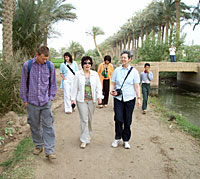 |
Nile valley “black earth” (kemet), as distinct from the “red earth” (deshret) of the desert. In their black land they felt content and safe. The regular cycle of natural events, including the Nile floods conferred a rhythm on their lives which was part of the maat, the eternal order of things. It was of course the peasant farmer whose link with the soil was strongest. He had learnt to cultivate it to perfection and gradually extended the area of his fields to wherever the annual floods reached. In the passage of time the size of his harvests and his herds grew to the point where, even in pre-dynastic times (4000--3000 BC), part of the population could turn to other employment. |
|
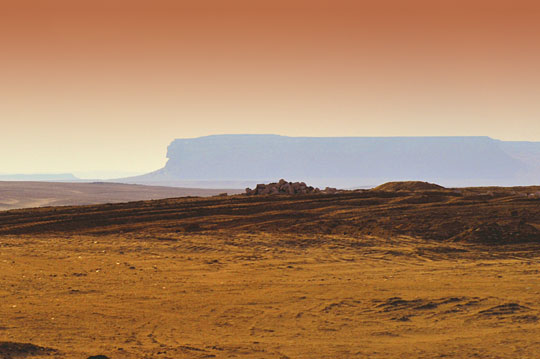 |
Western Desert Safaris
The Ancient Egyptians shunned the desert as far as possible. From the western wilderness of Deshret (the red lands) a scorching destructive wind, would sometimes blow down on them. Then, as now, clouds of fine sand and dust would engulf man and beast alike causing a disruption to the established order. No wonder they saw the desert as the domain of malignant forces personified in the God Seth.Yet, nevertheless there flourished life and culture, in a world within a world... |
|
|
The Blue Lotus organizes safaris to Bahariya Oasis, the famed White Desert and beyond.
|
|
 |
Imhotep Sakkara Museum
The Imhotep Museum is located at the foot of the Saqqara necropolis complex, near Memphis, in Egypt and was built as part of strategic site management. The Museum was opened on April 26, 2006, and displays finds from the site, in commemoration of the ancient Egyptian architect Imhotep. |
|
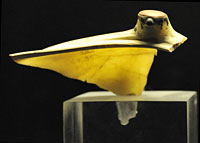 |
Professor Zahi Hawass said: "I felt that we should call it the Imhotep Museum in tribute to the first architect to use stone rather than perishable materials for construction on a large scale. This man was second only to the King and in the late period was worshipped as a god." The Museum also has a hall dedicated to a man, an important Egyptologist who excavated the Djoser complex all his life: the French Egyptologist Jean-Philippe Lauer. (wikipedia) |
|
| Sakkara Necropolis
Sakkara is a vast, ancient burial ground in Egypt, serving as the necropolis for the Ancient Egyptian capital, Memphis. Sakkara features numerous pyramids, including the world famous Step Pyramid, as well as a number of mastabas. Located some 30 km south of modern-day Cairo, Sakkara covers an area of around 7 km by 1.5 km. At Sakkara, the oldest complete hewn-stone building complex known in history, Djoser's step pyramid, built during the third dynasty. |
 |
|
Other Egyptian kings have built pyramids at Sakkara, which are now in various states of preservation or dilapidation. High officials have added private funeral monuments to this necropolis during the entire pharaonic period. It remained an important complex for non-royal burials and cult ceremonies for more than 3,000 years, well into Ptolemaic and Roman times. (wikipedia) North of the area known as Saqqara lies Abusir; south lies Dahshur. The area running from Giza to Dahshur has been used as necropolis by the inhabitants of Memphis at different times, and it has been designated as a World Heritage Site by UNESCO in 1979. The name Saqqara is possibly derived from Sokar, an ancient Egyptian funerary god. |
 |
|
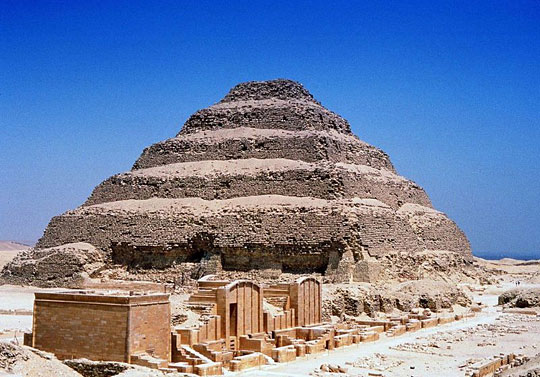 |
Step Pyramid Complex The Pyramid of Djoser (Zoser), or step pyramid (kbhw-ntrw in Egyptian) is an archeological remain in the Sakkara necropolis, Egypt, northwest of the city of Memphis. It was built for the burial of Pharaoh Djoser by his vizier Imhotep, during the 27th century BC. It is the central feature of a vast mortuary complex in an enormous courtyard surrounded by ceremonial structures and decoration. (wikipedia) |
|
| Abu Sir Complex Abu Sir is the name given to an Egyptian archaeological locality – specifically, an extensive necropolis of the Old Kingdom period, together with later additions – in the vicinity of the modern capital Cairo. The name is also that of a neighbouring village in the Nile Valley, from whence the site takes its name. Abusir is located several kilometres north of Sakkara and, like it, served as one of the main elite cemeteries for the ancient Egyptian capital city of Memphis. (wikipedia) |
 |
|
 |
Abu Gurab Complex Abu Gurab (also known as Abu Gurob and Abu Jirab) is a sun temple that built by the people of ancient Egypt. It was excavated by Egyptologists between 1898 and 1901 by Ludwig Borchardt on behalf of the Berlin Museum and is located near the city of Menfi. It was built to honor the Sun god Ra. The temple was constructed by the orders of Nyuserre Ini, the sixth king of the fifth dynasty of Egypt. The exact dates of his reign are unknown. It is estimated that he came to the throne sometime between 2450 BC and 2430 BC. |
|
 |
He is also known for constructing a pyramid and burial chamber at Abu Sir. Abu Gorab was probably constructed late in Niuserre's reign, sometime after 2420 BC. The temple was built solely for the purpose of honoring Ra, and was not used as a burial place. (wikipedia) |
|
| Giza Pyramid Complex The Giza Necropolis stands on the Giza Plateau, on the outskirts of Cairo, Egypt. This complex of ancient monuments includes the three pyramids known as the Great Pyramids, along with the massive sculpture known as the Great Sphinx. It is located some 8 km (5 mi) inland into the desert from the old town of Giza on the Nile, some 25 km (15 mi) southwest of Cairo city centre. One of the monuments, the Great Pyramid of Giza, is the only remaining monument of the Seven Wonders of the Ancient World. (wikipedia) |
 |
|
 |
Giza Sphinx Complex The Great Sphinx of Giza is a statue of a reclining lion with a human head that stands on the Giza Plateau on the west bank of the Nile, near modern-day Cairo, in Egypt. It is the largest monolith statue in the world, standing 73.5 m (240 ft) long, 6 m (20 ft) wide, and 20 m (66 ft) high. It is the oldest known monumental sculpture, and is commonly believed to have been built by ancient Egyptians in the third millennium BCE.(wikipedia) |
|
| Dashur Red Pyramid The Red Pyramid, also called the North Pyramid is the largest of the three major pyramids located at the Dahshur necropolis. Named for the light crimson hue of its exposed granite surface, it is also the third largest Egyptian pyramid, after those of Khufu and Khafra at Giza. At the time of its completion, it was the tallest man-made structure in the world. It is also believed to be the world's first successful attempt at constructing a "true" smooth-sided pyramid.
|
 |
|
The Red Pyramid was not always red. It used to be cased with white Tura limestone, but only a few of these now remain at the pyramid's base on the corner. During the Middle Ages much of the white Tura limestone was taken for buildings in Cairo, revealing the reddish pinkish limestone. (wikipedia) |
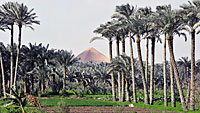 |
|
 |
Dashur Bent Pyramid The Bent Pyramid, located at the royal necropolis of Dahshur, approximately 40 kilometres south of Cairo, of Old Kingdom Pharaoh Sneferu, is a unique example of early pyramid development in Egypt, about 2596 BCE. This was the second pyramid built by Sneferu. The lower part of the pyramid rises from the desert at a 55-degree inclination, but the top section is built at the shallower angle of 43 degrees, lending the pyramid its very obvious "bent" appearance.(wikipedia) |
|
| Memphis Complex Memphis was the ancient capital of the first nome of Lower Egypt, and of the Old Kingdom of Egypt from its foundation until around 2200 BC and later for shorter periods during the New Kingdom, and an administrative centre throughout ancient history. According to Herodotus, the city was founded around 3100 BC by Menes, who united the two kingdoms of Egypt. It has been theorized that King Menes was possibly a mythical king, similar to Romulus and Remus, the mythical first rulers of Rome. Most likely Egypt became unified through mutual need, developing cultural ties over time and trading partnerships though it is still understood that the first capital of Ancient Egypt was the lower Egyptian city of Memphis. (wikipedia) |
 |
|
 |
Carpet School
Offering demonstrations featuring some beautiful craftsmanship in cotton, wool and silk. (nefertum.com) |
|
| Meidum Pyramid
The pyramid at Meidum is thought to have been originally built for Huni, the last pharaoh of the Third Dynasty. It was completed and probably usurped by his successor, Sneferu, who also turned it from a step pyramid to a true pyramid by filling in the steps with limestone encasing. The Meidum pyramid was built in different stages, beginning as a seven-step pyramid to which an additional step was added at a later stage. It appears to have collapsed sometime during the New Kingdom. A subsidiary pyramid is located on the south side, between the main pyramid and the enclosure wall, and a memorial temple is on its east side. (wikipedia) |
 |
|
 |
Make your reservations soon! Languages spoken: English, Français, Deutsch, Arabic |
| | HOME | ROOMS | MEALS | RATES | REVIEWS | PHOTOS | SAKKARA | BLUE LOTUS | NEW BOOK | MAP | CONTACT | |



